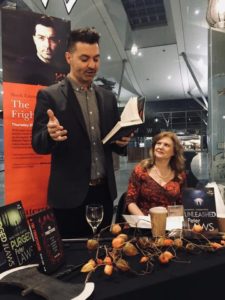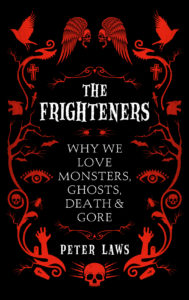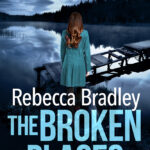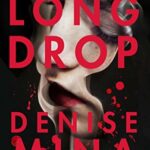Today I’m pleased to welcome crime author Peter Laws to the blog to talk about his revision process.
 Peter is the author of crime fiction novels Purged and Unleashed (
Peter is the author of crime fiction novels Purged and Unleashed (
Read his First Draft process HERE.
Your first draft has been completed, what state is it generally in?
Pretty good, in terms of story and plot. That’s because I tend to sort out the overall structure during the first draft. But there are still plenty of other things to deal with…
What is the first thing do before you start to revise?
I take a break. This is absolutely key, because when you’re working on a first draft (or any draft for that matter) it’s like putting on a Virtual Reality helmet. You sit at your computer, start typing, and this crazy world just grows up around you. It can feel like total immersion, which is seriously cool. Yet, the downside of that is that it becomes hard to tell the difference between what’s in your own mind and what is actually on the page in reality.
For example, I’ve written chapters that made perfect sense during the first draft, but when I read it back (after a break) I think – where on earth is this chapter supposed to be taking place? I was so immersed before that the locale was in my mind, but not in actual words on a page. So, a break can help you spot details that you want the reader to know, but you haven’t actually written them down. It works the other way too, where you can spot details that are included, that later you realise aren’t necessary.
I’ve also had the experience where I wrote an emotionally charged moment in which a character is so moved by a situation, that he breaks down in tears. When I wrote that in the first draft, my VR headset was working to full capacity, so I found myself in tears at my desk, just writing it! After a break however, I realized that the emotion of it all came through the connections I was making in my head to a personal situation. Reading it in a colder way helped me see that in terms of reality and words it just wasn’t upsetting enough to make the character burst into tears after all. The break helped me see that.
Remember that the vast majority of those who read your book (i.e. everyone else) will be ‘readers’. Whereas you’re the minority – ‘the writer’. If 99% of people who enter this story are not the writers of it, then it makes sense to see things from their angle. I find that taking a break does that. Without it, it’s like keeping that VR headset on constantly, which is when you lose perspective and ignore important details. Oh, and taking a break is a great time to kick back and read, watch movies, play videogames, eat ice-cream. Besides, my books can be pretty dark – so it’s nice to come up for air now and then!
How do you assess the damage that needs working on?
To me it’s more like what excess weight can I drop from this plane, so it flies more efficiently. So rather than assessing damage, I’m looking for things that can be jettisoned. I know that cutting stuff out can be painful for some writers, but if you’re writing popular fiction, the story is in charge, not you and your quirky interests. I’ve spent whole days writing entire sections of a book that really tickled me, only to cut it all out later. That isn’t a failure to me, nor is it a bad use of time. It’s just part of climbing a mountain. You go up one way and realise it’s not the correct route, so you cut back and try a better path. The ‘trying something out’ days are part of the journey. It’s not wasted.
In terms of cutting stuff, I take inspiration from film makers. I’m a bit of a movie geek and enjoy watching the special features on Blu Rays and DVDs. You can watch a deleted scene on those and think – man, this is a great scene and the writing is top notch. Yet you realise that another scene in the film achieves the same function as this one, which makes this just padding. Which is why they cut it. Sometimes less is more.
Do you allow anyone to read that very first draft before revisions or can you assess it objectively yourself?
I don’t let other people read my first draft as a rule. I want it to be in the best place possible before other eyes see it. That doesn’t mean I expect it to be perfect by any means. But it feels like I’m wasting people’s time by sending them a draft that I know has issues that need sorting out. It also might waste my time, too. Bringing other voices in too early stages can confuse things a bit. You might end up writing a book to simply fit the tastes of another person. I prefer to write the entire novel or non-fiction book as you think it should be, then let others read it. If it needs changes after that, then fine. It’s important to take advice and direction from editors. But getting a few friends or other writers at the writers group, to keep going over your stuff constantly might spoil the broth, as they say. Trust yourself more.
What do you initially focus on, when approaching the completed first draft of the manuscript?
Initially it’s story and plot (does this all hold together in a logical manner), then it’s character (are players in the story sharp and believable) then it’s enriching the environment (making the place come alive with sound, smell, touch etc), and then dialogue (creating realistic voices which say interesting things). Oh, and I also include theme in that. My books tend to follow a theme. This seems obvious in my non-fiction work, like The Frighteners – which asks ‘why do humans have a morbid streak?’ But while my are straight up macabre thrillers, they each explore themes. Purged explored forgiveness and the religious ritual of baptism, Unleashed explored guilt, and the desire for humans to find patterns. The third novel (name to be announced) looks at the theology of the Trinity and attitudes to fatherhood. So I also go through the book to make sure the themes are coming through.
But of course, even though I’ve put these elements in an order above, they may often all come at the same time, during a first draft. I just sent that third novel off to my publishers, for example, and when I wrote the first draft it was with the VR headset on. Many of the scenes had all of the above elements from the first time I wrote them, which is brilliant when that happens! However, not all parts of the book were anywhere near as mature. In that case, I tend to look out for the above issues, with story and plot being the key one to attend to first. I do that first because I don’t want to waste hours adding great extra nuance to a scene that I later realise is illogical or doesn’t fit into the plot! Better to make sure that the story works first and foremost, then if it still needs it, I add all the extra nuance above.
Do you have any rituals, writing or real-world, when revising a manuscript?
Just the same as when I do the first draft: a pot of Suki tea on this funky bamboo tray I got. I love that tray. Seriously. Oh, and I listen to a bunch of film scores and soundscapes playing as I write. I can’t think of any rituals specific to a rewrite other than I often change the playlist of music when I swoop through for the second time.
In what format do you revise, paper or computer?
Computer. Though I do sometimes copy and paste my work into an iPhone app called Voice Dream. It reads my work back to me in convincing sounding voices which can actually be a great way of spotting problems with the writing.
How messy is the revision process – can you go in and repair areas or does the whole manuscript get decimated?
I use Scrivener on the Mac, which makes the editing process pretty organized and easy. With that program, you can remove entire chapters, switch them around, or just throw them into holding file to get them out of the way. It’s a brilliant way of organizing a book-length work and is much less of a headache than using Word (which at times, is the bane of my professional life!). However, while Scrivener is great for the bulk of writing and editing, it can cause hassles when exporting it to Word (which I have to do for all of my different publishers or magazine editors that I write for). Also, Scrivener has a really steep learning curve. It took me days and days to get my head around how to use it, but I really feel like it was worth it in the end. I have battled in the trenches of Scrivener and survived! You can too – but at times, it’s full on, bloody war.
Is revision an overhaul of the story or is it minor editing?
If you’re a doctor, and the book is the patient, then revision is whatever the patient needs. If it has a gaping wound in its head then you need to sort that out, quick. If it just needs a little help learning to walk here and there, then offer that. It’s your job to diagnose what that first draft needs, and to administer the treatment in a timely manner. It’s certainly NOT your job to look at the patient, shrug and say, you’re too far gone mate…I’m leaving you to die. Then you move to some healthy-looking patient instead. That’s not very noble, and probably breaks the Hippocratic oath. I think some writers pronounce the death of their own books prematurely – which is kind of tragic.
What’s the biggest change you’ve made to a story during this process?
When I was first starting out I was desperate for a publishing deal. Bear in mind that I wrote four full novels over five years and was about to give up before I got three book deals in the space of a few months. Amazing! But it means I know what it’s like to be desperate to get a deal. So once I (foolishly) spotted that more books were written in the present tense than the past. Aha, thought I…that’s the key to getting a publisher. So, I decided to go back through and change the tense of the book. Man, was that a waste of my life! Thankfully I realized early on that my initial instinct was correct, and I just stuck with the original plan. Since then, I’ve been cautious not to make huge changes based on something I spotted in a book shop that day, or a trend I see in the publishing world. Those trends will be old news by the time your book comes out, so just stick with your instincts, I reckon.
When first drafting, many writers keep track of progress by counting words in a day. How do you make sure you’re progressing as you’re revising?
We’ve chatted before about first drafts, and I said that I don’t track progress by word count as I think that can be an unhelpful measure of success (i.e. 750 words you can be proud of is much better than 2, 000 words of utter crap). Therefore, I apply the same first-draft principle to revision – it’s all about time. I need to make sure that I’m devoting a decent amount of time and focus to it: that’s the measure. The point is to actually write, not just spend all day thinking, or talking, about writing (as fun as that can be). Obviously, this all has to happen within the deadline the publishers have given you (or indeed, that you have given yourself. I’m a big believer in personal deadlines, but that’s another story). Back to revisions…
Do you prefer to write the first draft, or do you prefer the revision process?
Ooo, that’s a hard one. I like and dislike them both in equal measure. The first draft of fiction can be amazing, because all this stuff is just popping into your head and you’re writing it down. That’s probably the most thrilling moment in writing. When it’s being revealed to you. However, I also love having an entire book ready to start tinkering with. One of my favourite parts is when the book has gone through all its main drafts, and it just needs little tweaks here and there. Like yesterday, when I just had to make sure that all the chapter numbers were write. After a year of writing, you get a sort of ‘schools out’ feeling when you reach that stage!
What do you drink while you’re working?
Lots of loose leaf tea, inc. Rooibos, Lapsang Souchong and Earl Grey. Oh, and water! I don’t like coffee, I’m afraid.
How long does this process take and what shape is the book now in?
It’s unpredictable how long this all might take, but obviously it has to take place within the deadline. I never think to myself – maybe I’ll ask them to extend the deadline. I love the idea of aiming to finish well before a certain date. When the deadline date does arrive, I’m usually too immersed in the story anyway, so it feels ‘right’ to hand it over. Even if I think another read through might feel helpful, the deadline stops me tinkering too long.
But the timing can still be unpredictable. For example, I finished my latest scary novel a couple of weeks ago and was ready to send it off about ten days before the deadline. But when I moved the file from Scrivener to Word I saw it in a different format and something about that changeover made me re-read the first chapter. That prompted me to do another complete read through just to cut down a bit more and to make things a bit smoother. That set me back a week. I also had a family illness that delayed things too. However, because I always aim to finish a book about a month before the official deadline – then it gives me time at the end to do extra bits. That’s not me trying to sound impressive by the way. I’m sure there’s some deep, psychological insecurity in me that makes me so keen to finish well before a deadline.
Thanks for showing us the inner workings!
Thank you. Now if you’ll excuse me…I seem to have a new patient at the door.
You can find Peter on his Website | YouTube | Podcast
The Frighteners: Why We Love Monsters, Ghosts, Death & Gore
 The Frighteners follows the quest of Peter Laws, a Baptist minister with a penchant for the macabre, to understand why so many people love things that are spooky, morbid and downright repellent. He meets vampires, hunts werewolves in Hull, talks to a man who has slept on a mortuary slab to help him deal with a diagnosis, and is chased by a chainsaw-wielding maniac through a farmhouse full of hanging bodies.
The Frighteners follows the quest of Peter Laws, a Baptist minister with a penchant for the macabre, to understand why so many people love things that are spooky, morbid and downright repellent. He meets vampires, hunts werewolves in Hull, talks to a man who has slept on a mortuary slab to help him deal with a diagnosis, and is chased by a chainsaw-wielding maniac through a farmhouse full of hanging bodies.
Staring into the darkness of a Transylvanian night, he asks: What is it that makes millions of people seek to be disgusted and freaked out? And, in a world that worships rationality and points an accusing finger at violent video games and gruesome films, can an interest in horror culture actually give us safe ways to confront our mortality? Might it even have power to re-enchant our jaded world?
Grab your crucifixes, pack the silver bullets, and join the Sinister Minister on his romp into our morbid curiosities.
You can read the other Q&As in the Revision process series HERE.
The First Draft series can be found HERE.



It’s always so helpful to learn how other writers do their revisions. Thanks, both. I agree about leaving a manuscript alone for a bit. It’s really worth that extra time. And I like that analogy to a doctor providing what a patient needs.